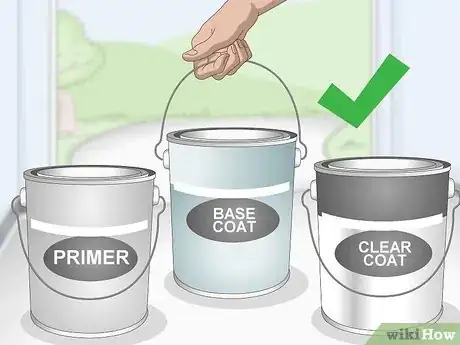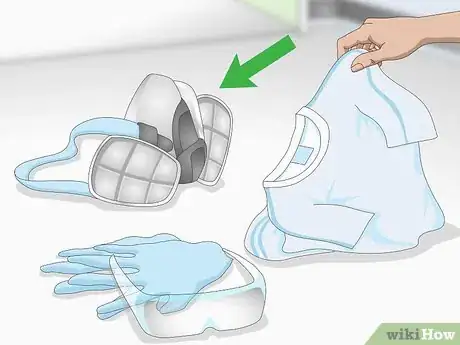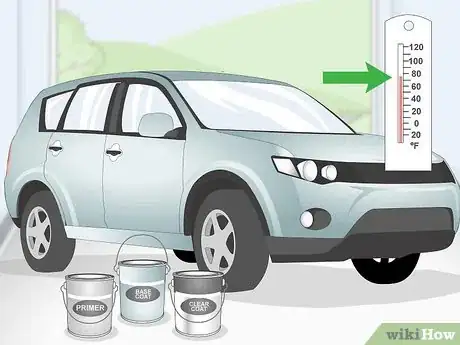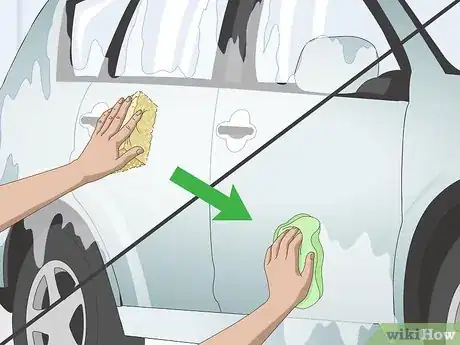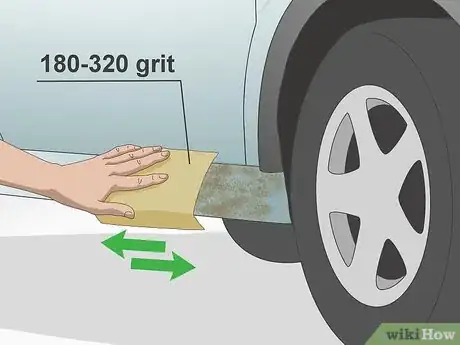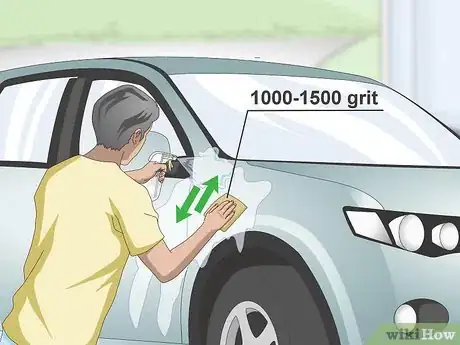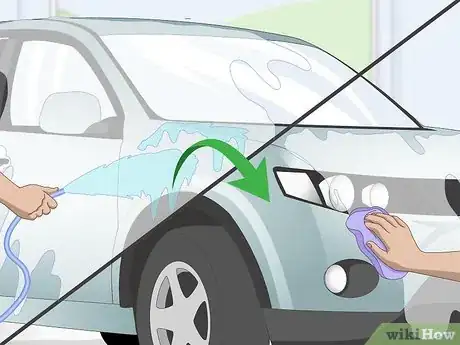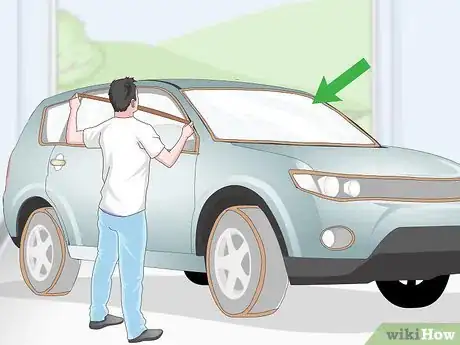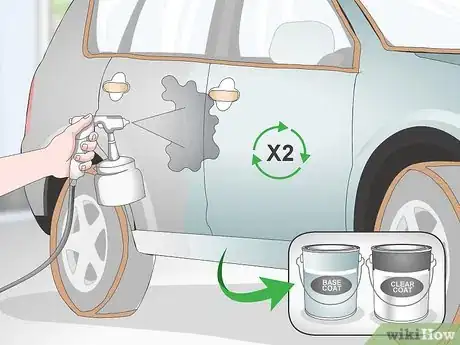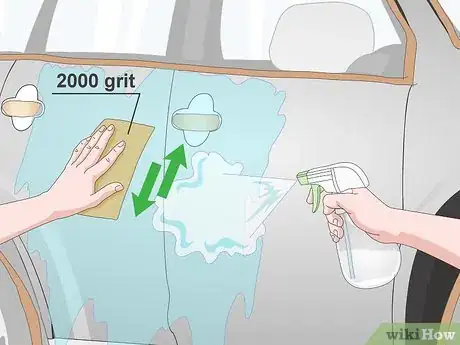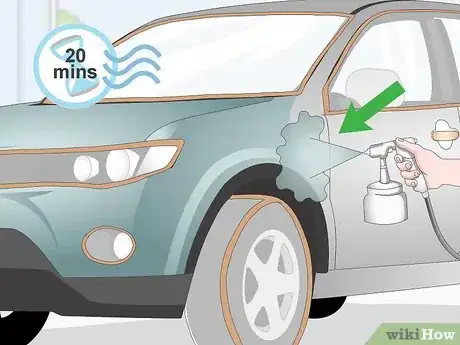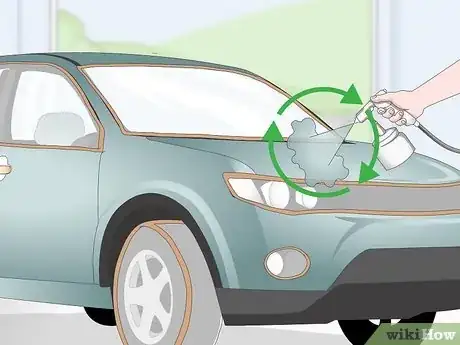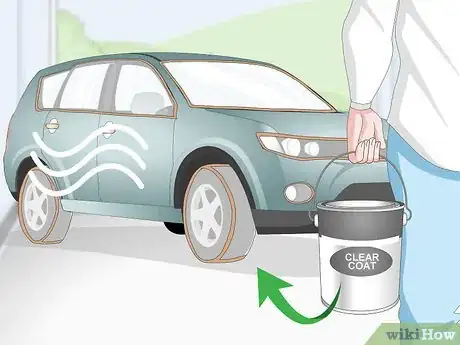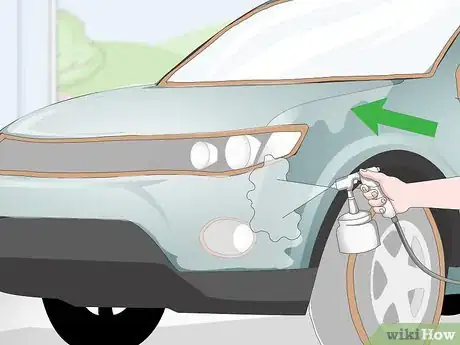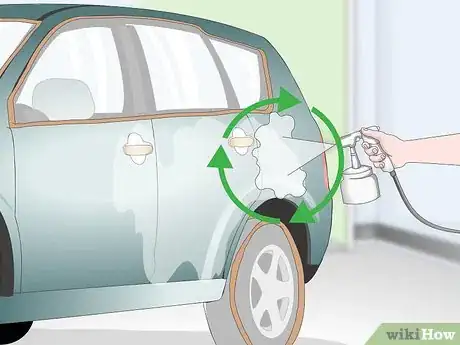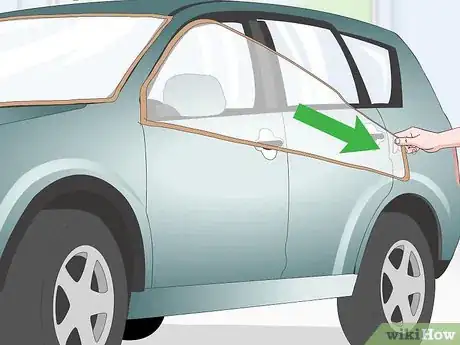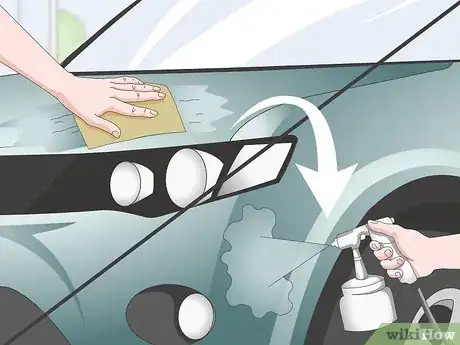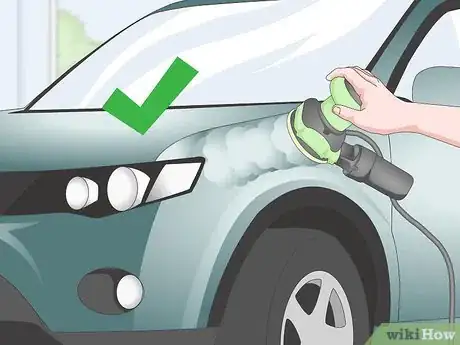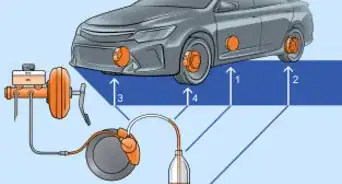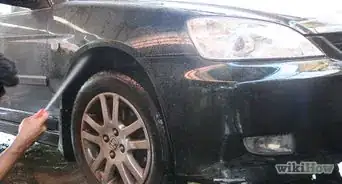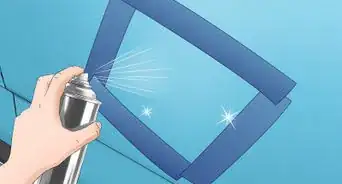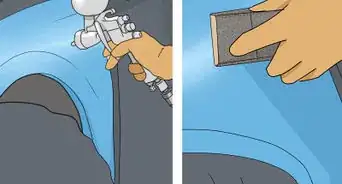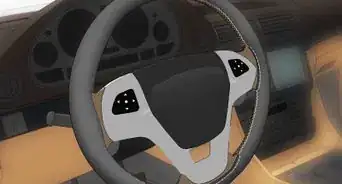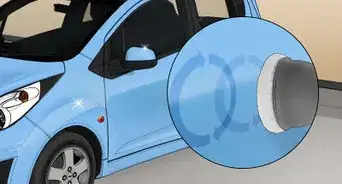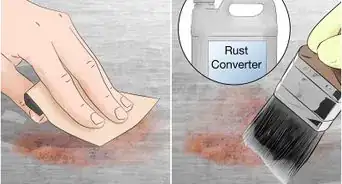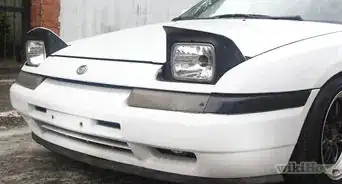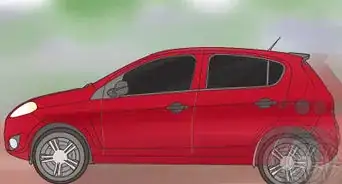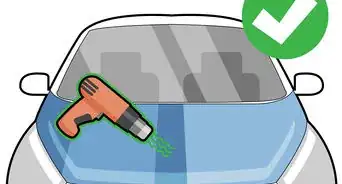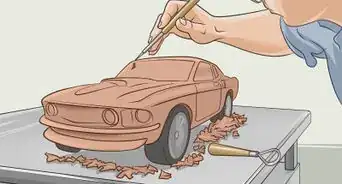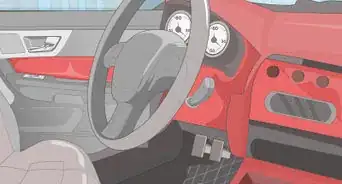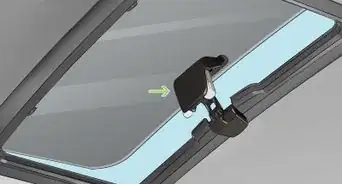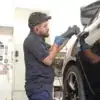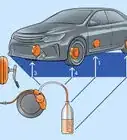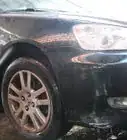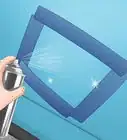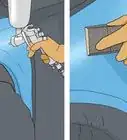This article was co-authored by Angel Ricardo. Angel Ricardo is the owner of Ricardo's Mobile Auto Detail headquartered in Venice, California. With over 10 years of experience in mobile detailing, Angel continues to attend auto detailing trainings to improve his customer service and auto detailing skills.
There are 10 references cited in this article, which can be found at the bottom of the page.
wikiHow marks an article as reader-approved once it receives enough positive feedback. This article received 15 testimonials and 87% of readers who voted found it helpful, earning it our reader-approved status.
This article has been viewed 873,960 times.
When you spray paint your car yourself, you first apply a primer, then a base coat, and then a clear coat, but it can be difficult to get these coats to look even because the paint has a tendency to run. Thankfully, with some patience and the right tools, you can get that perfect glossy finish and save thousands of dollars on a professional paint job. You’ll need to devote several days to the process and make sure to follow safety guidelines.
Steps
Gathering Materials and Prepping the Vehicle
-
1Buy enough primer, base coat, and clear coat to cover your vehicle. For a small- to medium-sized car, you’ll need 1 gallon (3.8 L) of primer, 3 gallons (11 L) of base coat, and 2 to 3 gallons (7.6 to 11.4 L) of clear coat. For larger vehicles, double those amounts.[1]
- If you want to match your car’s original color, check your car’s compliance plate to find the color code. You can give that to an auto paint store and they’ll be able to match the color for you.
- It’s always better to have a little extra paint rather than too little. Remember that you can save excess paint for touch-ups.
-
2Assemble your protective gear before you start working. You will need a respirator, protective eyewear, disposable gloves, and clothes that you don’t mind getting dirty. Check the manufacturer’s instructions on the primer, base coat, and clear coat for any other safety stipulations.[2]
- If you don’t own a respirator, you may be able to rent one from your local hardware store.
Advertisement -
3Work in a location that is 70–80 °F (21–27 °C) for the best results. Depending on the weather, you could definitely work outside—just make sure to check that the weather forecast will be clear for a few days. If you live in an area with high humidity, it will take longer for each coat of paint to dry, so consider working climate-controlled space if you can—just ensure you’re working somewhere that has good ventilation.[3]
- Working in the right temperature will help the paint dry properly.
-
4Wash the car with dish soap and water and dry it with a lint-free towel. Grab a big bucket and fill it with warm water and a few squirts of dish detergent. Then use a large sponge and wash your car, starting at the top and working your way to the bottom. Once the entire car has been washed, use a lint-free towel to dry it off thoroughly.[4]
- The car needs to be completely free of wax, oil, and dirt, and the dish soap is gentle enough to clean everything off without leaving a soapy residue.
-
5Sand out any rust spots or scratches with 180-320-grit sandpaper. If you have a sander, load the sandpaper into it and work on sanding out any areas that have rust or that are scratched up. You’ll be sanding the entire body of the car later, but this pre-step will help prep those areas to receive the primer, base, and clear coats.[5]
- Sand corners and small crevices by hand to ensure they’re fully prepped. The sanding machine won’t be about to maneuver such small spaces.
-
6Wet sand the entire car using 1000-1500-grit wet sandpaper. You will need specific wet sandpaper and a spray bottle filled with water. Spray a section of the car, and start sanding in a back and forth motion (not in a circle). Continue this process until the entire car is smooth, refilling the water bottle as needed. If the paint job you’re replacing or fixing is really patchy, sand until you get down to the bare metal frame. If the paint job wasn’t bad to begin with, just sand until you get an even, smooth-to-the-touch surface.[6]
- Wet sanding makes a really smooth surface as apposed to the coarser surface that comes from regular sanding.
- You can’t get the car over-wet, so don’t worry about how much water you spray.
- Use rubber sanding blocks if you don’t have a sander.
-
7Rinse down the car and dry it off again with a lint-free towel. Pay attention to the body of the car as you rinse it this second time. If there are any areas that need to be sanded again, take time now to do so. Once the car has been rinsed, dry it thoroughly with the towel.[7]
- Rinsing the car off again ensures that all the little flakes of paint and sandpaper are gone.
-
8Tape off the windows, lights, and tires with masking tape and plastic. Place the tape around the seam of each area that you don’t want to paint. Then cover those areas with plastic sheeting and apply a second layer of masking tape to keep the cover in place. Use a putty knife to press the tape down into cracks and crevices.[8]
- If you don’t have plastic film or sheeting, use 2-3 layers of old newspaper.
- Check out some online tutorials for extra tips and examples of taping off your car.
- If you’re working in an area with other tools or furniture, you may also want to spread some plastic sheeting over them to keep them clean.
Priming the Car and Applying the Base Coat
-
1Apply 2 coats of primer before applying the base and clear coats. Check the primer manufacturer’s instructions before you start—chances are you will need to mix the primer with a thinner first. Once your mixture is ready to go, load it into the spray gun. Hold the gun about 6 inches (15 cm) from the body of the car and spray in a back and forth motion until the entire body of the car is covered. Wait about 20 minutes between each coat.[9]
- Use an old piece of wood or scrap metal to practice spraying the primer before you begin on your car. This’ll help you get the feel for the machine.
-
2Sand the vehicle with 2000-grit wet sandpaper after the primer dries. The primer will leave a slightly uneven and powdery layer on the car, so use your spray bottle and wet sandpaper to gently go over the entire vehicle. Just sand enough so that the surface is completely smooth.[10]
- Wipe down the sanded, primed car with a damp rag once you’re done and let it dry completely before moving on to the base coat.
-
3Spray on the first coat of the base coat and let it dry for 20 minutes. Check the instructions of the base coat to see if it also need to be mixed with thinners. Load the liquid into your cleaned-out spray gun. Hold the sprayer 6 to 10 inches (15 to 25 cm) away from the car and use smooth, even strokes, going from left to right rather than up and down or in circles.[11]
- It should take you about 10 minutes to apply the first base coat if you’re painting a small- to medium-sized vehicle.
-
4Apply a second coat of the base coat after the first one has dried. Use the same technique as before, moving in slow, even, strokes. This is a great time to check over the vehicle and make sure things are looking even. Once the second coat has been applied, clean out your spray gun to get it ready for the clear coat.[12]
- If you can still see the metal of the frame through the primer and base coat, you may want to add a third base coat.
-
5Let the base coat dry completely before moving on to the clear coat. It’ll usually take about 30 minutes for the base coat to dry, but depending on the temperature and humidity, it could take closer to 60 minutes. You’ll know it’s dry when it’s smooth to the touch and your fingers don’t drag on it when you touch it.[13]
- If you notice any residue or bumpy areas, sand the area down again and reapply the base coat until it’s even.
Applying the Clear Coat and Finishing the Job
-
1Spray the first coat of the clear coat evenly over the base. Fill your spray gun with the clear coat, following any manufacturer’s specifications from the paint can. Start at the top of the vehicle and spray from left to right as you make your way down to the bottom of the car. Use even, long strokes. Wait 10 minutes after this first coat before applying the second.[14]
- The clear coat should be easy to see as it goes on the car, so take your time to make sure the entire body is evenly coated.
- You’ll know the clear coat is dry when it is smooth to the touch, rather than sticky.
-
2Apply the second clear coat to create a nice, glossy finish. Once the first clear coat has dried, repeat the process to apply the second (and final!) coat. Remember to use smooth, even strokes and to completely coat the entire body of the car.[15]
- If you want, or if you applied particularly thin first and second coats, you could do a third coat, though two is usually sufficient.
-
3Remove the masking tape and plastic before the paint dries. Right after you apply the last clear coat, carefully peel away the masking tape and plastic sheeting or newspaper. Do this slowly and try to keep the plastic from touching or getting stuck in the clear coat.[16]
- If there is sticky residue left from the tape, ignore it for now. You can go back to it later and rub it away using something like Goo Gone.
-
4Fix any mistakes or uneven areas by sanding and respraying the area. Be careful when doing this since you’ve already removed the tape and protective sheeting. Chances are, if you have to fix anything, it’ll just be a small section that you can carefully spray again.[17]
- Remember that you can always use this process of sanding and spraying to fix small scratches in the future, especially if you have leftover paint.
-
5Buff your clear coat for a glossy finish. Make sure the clear coat is completely dry before you buff. You can rent a buffer from your local hardware store if you don’t own one. Use a low setting and buff carefully but quickly—if you leave the buffer on any particular spot for too long, it could burn or wear away the paint you just applied.[18]
- You don’t have to buff your car if you don’t want to, but it definitely makes it look shinier!
Expert Q&A
Did you know you can get expert answers for this article?
Unlock expert answers by supporting wikiHow
-
QuestionWill clear coat protect my car?
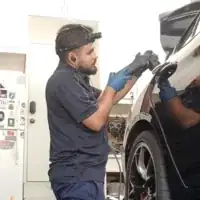 Angel RicardoAngel Ricardo is the owner of Ricardo's Mobile Auto Detail headquartered in Venice, California. With over 10 years of experience in mobile detailing, Angel continues to attend auto detailing trainings to improve his customer service and auto detailing skills.
Angel RicardoAngel Ricardo is the owner of Ricardo's Mobile Auto Detail headquartered in Venice, California. With over 10 years of experience in mobile detailing, Angel continues to attend auto detailing trainings to improve his customer service and auto detailing skills.
Auto Technician
-
QuestionHow thick should my clear coat layer be?
 Angel RicardoAngel Ricardo is the owner of Ricardo's Mobile Auto Detail headquartered in Venice, California. With over 10 years of experience in mobile detailing, Angel continues to attend auto detailing trainings to improve his customer service and auto detailing skills.
Angel RicardoAngel Ricardo is the owner of Ricardo's Mobile Auto Detail headquartered in Venice, California. With over 10 years of experience in mobile detailing, Angel continues to attend auto detailing trainings to improve his customer service and auto detailing skills.
Auto Technician
-
QuestionWhat actually is clear coat?
 Angel RicardoAngel Ricardo is the owner of Ricardo's Mobile Auto Detail headquartered in Venice, California. With over 10 years of experience in mobile detailing, Angel continues to attend auto detailing trainings to improve his customer service and auto detailing skills.
Angel RicardoAngel Ricardo is the owner of Ricardo's Mobile Auto Detail headquartered in Venice, California. With over 10 years of experience in mobile detailing, Angel continues to attend auto detailing trainings to improve his customer service and auto detailing skills.
Auto Technician
Warnings
- Mix paint and solvent in a well-ventilated area away from all sources of flames.⧼thumbs_response⧽
- Make sure to follow the paint manufacturer’s requirements as far as safety and protective equipment goes.⧼thumbs_response⧽
Things You’ll Need
- High-grit sandpaper
- Wet sandpaper
- Sander or sanding blocks
- Spray bottle
- Water
- Lint-free towel(s)
- Bucket
- Dish soap
- Large sponge
- Buffer
- Primer
- Base coat
- Clear coat
- Spray gun
- Disposable gloves
- Respirator
- Safety eyewear
References
- ↑ https://www.popularmechanics.com/cars/how-to/a3110/a-diy-guide-to-painting-your-car-15998013/
- ↑ https://www.quora.com/What-materials-do-you-need-to-paint-a-car
- ↑ https://youtu.be/zQMAY1LtSb8?t=88
- ↑ https://www.popularmechanics.com/cars/how-to/a3110/a-diy-guide-to-painting-your-car-15998013/
- ↑ https://www.popularmechanics.com/cars/how-to/a3110/a-diy-guide-to-painting-your-car-15998013/
- ↑ https://www.thoughtco.com/wet-sand-cars-primer-or-paint-281367
- ↑ https://www.thoughtco.com/wet-sand-cars-primer-or-paint-281367
- ↑ https://youtu.be/43gY1Ir4JqU?t=38
- ↑ https://www.popularmechanics.com/cars/how-to/a3110/a-diy-guide-to-painting-your-car-15998013/
- ↑ https://www.popularmechanics.com/cars/how-to/a3110/a-diy-guide-to-painting-your-car-15998013/
- ↑ https://youtu.be/iP6GAU2mSvU?t=44
- ↑ https://youtu.be/iP6GAU2mSvU?t=91
- ↑ https://youtu.be/iP6GAU2mSvU?t=169
- ↑ https://youtu.be/iP6GAU2mSvU?t=169
- ↑ https://youtu.be/iP6GAU2mSvU?t=225
- ↑ https://www.popularmechanics.com/cars/how-to/a3110/a-diy-guide-to-painting-your-car-15998013/
- ↑ https://www.popularmechanics.com/cars/how-to/a3110/a-diy-guide-to-painting-your-car-15998013/
- ↑ https://youtu.be/zQMAY1LtSb8?t=348
About This Article
To apply a clear base coat paint job to your car, wash the car with soap and water, and use a lint-free towel to dry the car completely. Wet sand all of the paint with 1000-1500 grit sandpaper, and rinse and dry the car before taping off the windows and other fixtures you don't want to paint. Then, use a sprayer to apply 2 coats of primer to the car and wet sand with 2000 grit sandpaper. Apply 2 coats of the base coat, and then wait for the paint to dry completely before sealing with 2 coats of clear coat. For tips on fixing mistakes and buffing the paint, scroll down!
